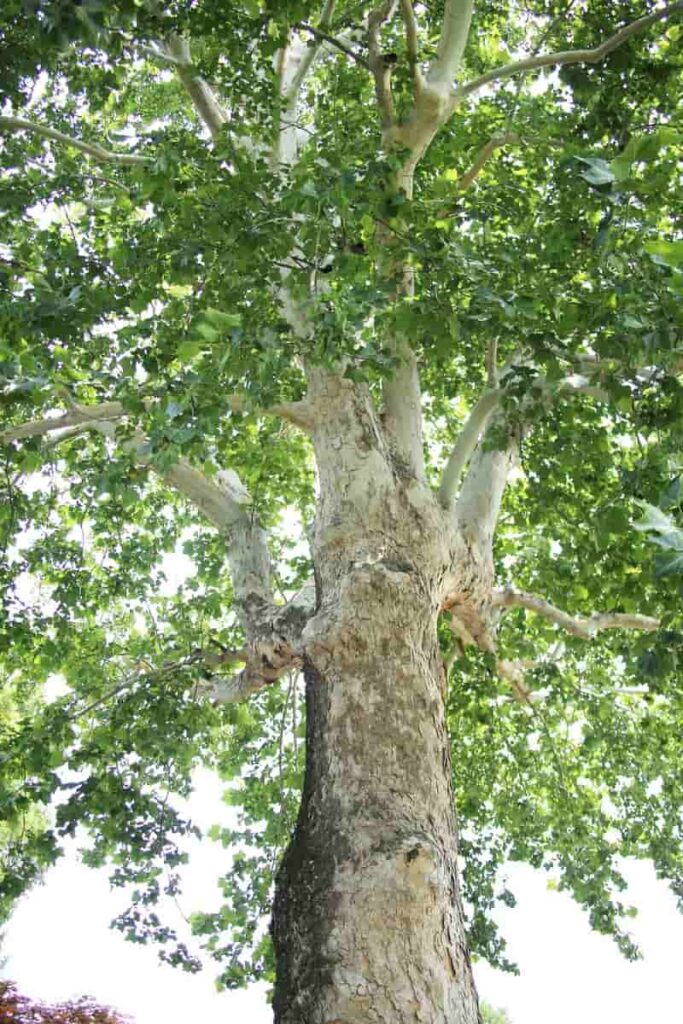A Sycamore tree makes a handsome shade tree for large landscapes. One of the most striking features of this tree is its bark, which has a camouflage pattern consisting of gray-brown wood beneath a layer of gray-brown bark that peels off in patches. Trees of the Sycamore family range from 40-100 feet in height and spread from 40-70 feet in width. The trunks of older trees tend to be solid, light gray. Let’s check out more information on growing Sycamore trees below.
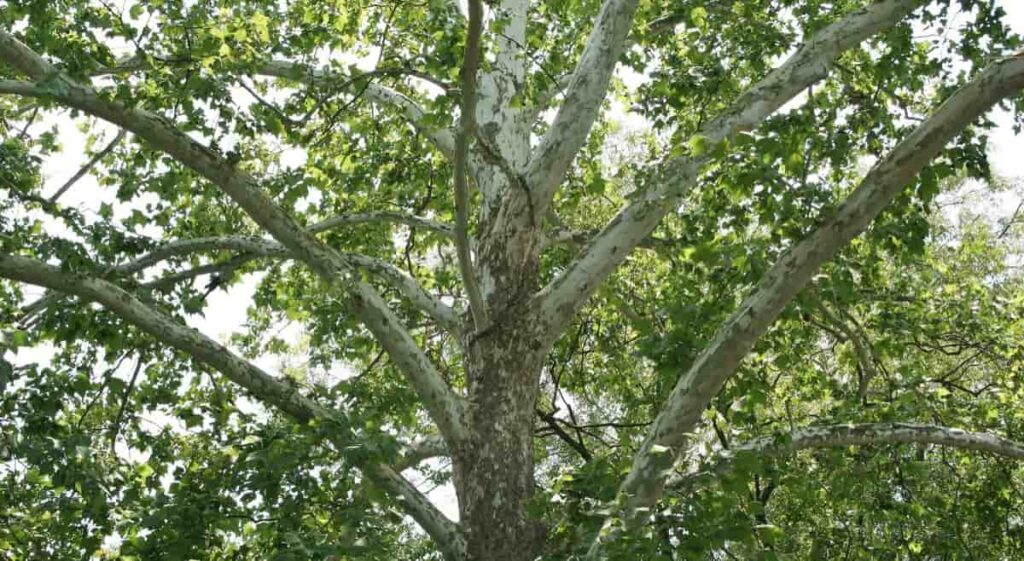
The buttonwood tree and the buttonball tree are also names for Sycamores. These plant balls hang from the tree in winter and fall to the ground in the spring. A twig of 3 to 6 inches hangs from each ball. Fall will also bring these fruits to the ground. The heartwood of Sycamores is strong and has several uses, but as the tree ages, it is attacked and consumed by fungus. As a result of the fungus, the tree becomes weak and hollow rather than killed.
As nesting sites, shelter storage chambers, and nuts, hollow Sycamore trees benefit wildlife. Sycamore trees are impractical for the average home landscape, but they make excellent shade trees in parks, stream banks, and other open areas. Formerly used as street trees, they produce a lot of litter and damage sidewalks with their invasive roots. However, it is still possible to see them along streets in older suburban neighborhoods.
Due to their inclination to establish a sturdy trunk, Sycamores tend to develop an aggressive root system, so plant them at least 15 feet from your house or sidewalk. Unfortunately, its proximity to nearby structures threatens the tree’s health. In addition, need to spend money on repairing any damage it might cause to your home’s foundation, driveway, or water lines.
Growing Sycamore tree
Types of Sycamore trees
American Sycamore
Also known as a plane tree, a buttonball, or buttonwood, the American Sycamore is native to North America. A large tree can sometimes reach 150 to 170 feet, but it usually grows to 100 feet tall. Sycamores are commonly used as street trees, park trees, reclamation plants, and home landscaping plants because they grow quickly, tolerate different soil types, and last a long time.
California Sycamore
The California Sycamore is also called western Sycamore or California plane tree because of its similar growth and appearance to the American Sycamore. A graceful, leaning habit is characteristic of this tree. It is generally planted as a street tree and landscaping tree in California. California Sycamore trees can reach 98 feet in height in less than 25 years if cultivated rapidly. Wildlife depends on California Sycamore trees for shelter, food, and nesting sites, including owls, hawks, woodpeckers, hummingbirds, and other songbirds. In addition, western tiger swallowtail butterflies eat its leaves as larval food.
Arizona Sycamore
Sycamores in Arizona are closely related to those in California, and some botanists consider them subspecies. Canyons, streams, and rivers in the south and central Arizona are home to this species. It is well known for its sculptural trunk and branches, and the Arizona Sycamore’s bark peels to reveal mottled brown, tan, and gray areas. Landscapers also use it as a tree for landscaping
In case you missed it: Growing Calla Lily in Your Garden: A Guide to Propagation, Planting, and Care
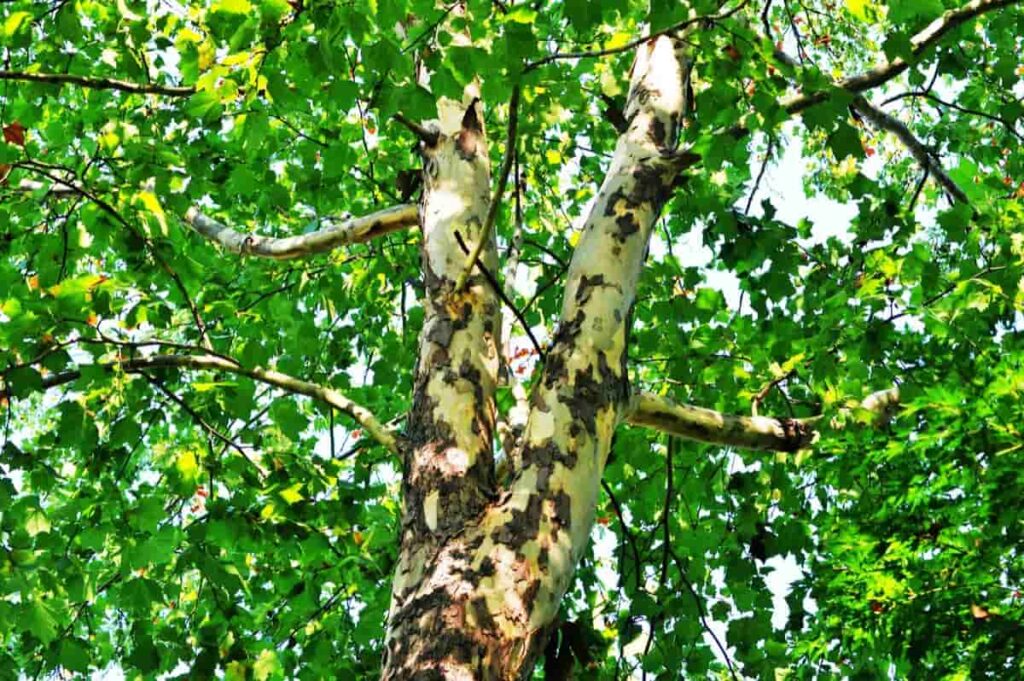
English Sycamore
The species is thought to be a hybrid of the American Sycamore and the Oriental Sycamore native to Eurasia. English Sycamores are popular street trees in Europe and the United States. Originally grown from seed, the London plane tree is also known as the London plane. A mass planting of English Sycamores has a more formal and uniform appearance since they are smaller and straighter than other Sycamores.
The tree tolerates pollution and urban environments well, making it a good landscaping tree. Compared to other Sycamore species, it has a darker bark with purple-gray and drab green tones. A London plane tree is pollarded yearly when planted as a street tree, in which the main branches are pruned back to stubs.
Best soil condition for Sycamore trees to thrive
Fertile soil with plenty of nutrients is ideal for Sycamores. Combined with alkaline soils and loads of pollution, alkaline soils encourage disease and stunt tree growth. Choose acidic soils. Clay, sand, and other soil types are no problem for Sycamores. It’s just a matter of making sure the soil drains well. Although this tree prefers deep, moist, rich soils, too much water can cause it to suffer.
As a result of waterlogging, root rot can easily develop. A tree can die from root rot, which is not good. Plant this tree in a spot that does not overshadow flowerbeds when evaluating your yard. Also, the dense shade created by this tree’s canopy will prevent lawn grass from growing well.
Amount of sunlight required for growing Sycamore tree
Plant a Sycamore tree that receives six or more hours of sunlight daily. If you are growing it in a container, place it against a south-facing wall where it gets plenty of sunlight. It is best to grow Sycamore where the temperature ranges between 18°C and 24°C.
How to grow Sycamore tree from seeds
- It is best to plant Sycamore trees from seed early spring since the seed balls will thoroughly dry out on the tree over the winter.
- Identify a golden-brown or grayish seed ball and gather it. If they feel excessively wet or squishy when squeezed, avoid them.
- In a paper bag, place the Sycamore seed ball. The top should be folded closed. Using a rubber mallet, gently tap the seed ball to break apart the seeds. Grasp two or three healthy-looking seeds and toss the rest in the green waste bin or compost heap.
- Choose a site that will accommodate a mature Sycamore tree. Place the tree at least 20 feet away from power lines, looming structures, and other trees. Plant Sycamores away from areas that remain sopping wet all the time as their wood will become brittle.
- Take a trowel to the planting site and scoop up the soil. Approximately one-third of a 6-inch round nursery container should be filled with soil. The soil should be mixed with equal parts vermiculite and coarse sand. Ensure the components are well integrated and the mixture has a uniform appearance.
- The soil mixture should be soaked in water until it flows freely from the bottom of the nursery container. The soil mixture should be allowed to drain for at least 20 minutes before planting Sycamore seeds.
- The Sycamore seeds should be sown at a depth of 1/8 inch in the nursery container. Make sure the soil is firm over the seeds. For the Sycamore seeds to germinate, spread a light layer of coarse sand across the soil’s surface.
- A sunny, south-facing wall is the best place to place the nursery container. If the year is dry, water the seeds every two weeks to a depth of 2 inches; otherwise, let Mother Nature take care of it.
- In four to six weeks, you should observe signs of germination. Seedlings should be thinned out if more than one germinates. The Sycamore seedlings that seem to be the healthiest and most robust should be removed.
- Sycamore seedlings should be transferred into 1-gallon nursery containers once they reach 6 inches in height. Water it well to a depth of 2 inches, and do not let the soil dry out completely for more than three days.
- As soon as the Sycamore tree tops 12 inches in height and bears several sets of fully-formed leaves, plant it in the chosen planting site.
- During its first summer, water the sapling every 10 to 15 days to a depth of 2 inches, then cease all additional watering once the rainy season begins.
In case you missed it: How to Grow Oregano from Seed to Harvest: Check How this Guide Helps Beginners
Propagating Sycamore trees from stem cuttings
Taking softwood cuttings or seeds can be used to propagate Sycamore trees. In contrast, if your plant is a cultivar, you can only propagate it by taking summer cuttings. Cuttings can be propagated from Sycamore cultivars as follows:
- Make sure you use a sharp knife when cutting. You should select a branch with two pairs of leaves and two buds on the bottom. Take a shoot between 6 and 8 inches in length.
- Potting soil should be filled into a planting container. Then, make a hole in this soil with a pencil.
- Leaves should be removed from the bottom of the branch, but the buds should be kept.
- Make sure the cutting’s bottom is dipped in a rooting hormone. Then insert it into the hole.
- Ensure the potting soil is well watered. Indirect light and a warm, sheltered location are the best spots to place the cutting.
- Keeping the potting soil moist is important until cutting forms roots. You can do this by sticking a small stake into the planting container and hanging a clear plastic bag over it. Then, mist the potting soil regularly after lifting the plastic bag.
- Once the cutting has put out roots about one inch long, remove the plastic tent. Maintain a moisture level in the soil evenly.
- After the frost danger has passed, transplant the rooted cutting into the yard.
In case you missed it: How to Grow Evergreen Hedge Plants: Best, Easiest, Fastest, and Low-Maintenance for Borders and Privacy
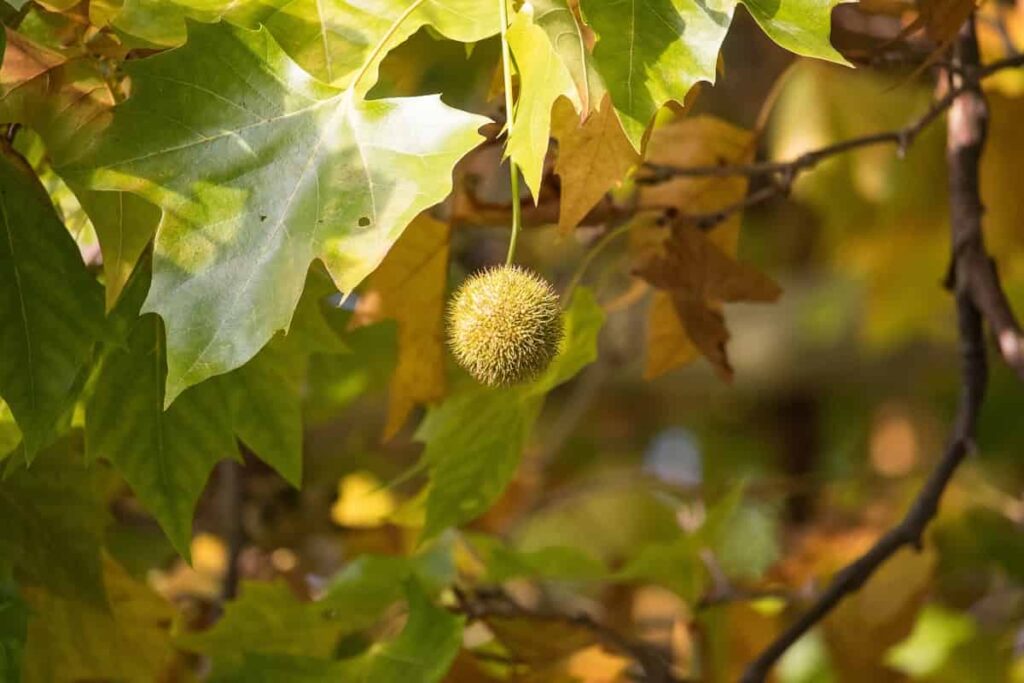
Sycamore tree care and maintenance
When and how to water your Sycamore plants
This species prefers moist soil and is not very tolerant of drought. Watering your tree is recommended during dry periods, especially in the summer, but you do not need to worry about the amount. How much water these plants should be supplied depends on the soil. At a depth of two inches, check the soil for moisture. If it is moist, there is no need to water. However, it is important to water the tree if it is dry. You should not water your plants if the weather is below freezing. When trees are planted, they need watering for the first two years – but older trees may need watering more frequently.
How and when to fertilize your Sycamore plants
A multipurpose fertilizer with a 10-10-10 ratio works well. It is recommended to apply liquid fertilizer three or four times per year, starting in late April and ending in mid-July. The fertilizer should be mixed with water and applied the same as water. Following the directions on the package is the best way to use stake-type fertilizers. When using any of the above techniques, it is recommended to use a higher nitrogen mix, such as 20-20-20. Manure, for example, can also be used successfully as an organic fertilizer. When a tree matures, less fertilizer or fewer nitrogen mixes should be used.
Pruning of Sycamore tree
Generally, Sycamore trees should only be pruned when their limbs have been damaged. Pruning damaged limbs back to the collar is recommended. Any dead or diseased branches should be pruned as soon as they are spotted. Occasionally, you may need to correct a branch that grows in a radically vertical direction, forming a tight crotch with the trunk. Pruning of this type should be performed by a professional. Generally, Sycamore trees produce horizontal limbs that are pleasing to the eye.
Branches that grow directly from the tree’s trunk should be cut back into two main branches. Be prepared to trim them back when new branches begin to grow within the next couple of years. By doing so, you will prevent the canopy of the tree from becoming too dense. A massive canopy blocks out the light at the base of the tree. Therefore, growing flowers or grass in that area will be difficult.
Overwintering of Sycamore tree
The mature Sycamore tree is very resilient in weathering storms and cold weather. The young Sycamores, however, tend not to be as resilient because they have not been battle-tested. So they need to get a few seasons under their belt to help them toughen up. In temperatures lower than -37°C, your young Sycamore tree cannot survive.
In case you missed it: How to Grow Curry Leaf Plants Faster: Best Tips to Increase Yield
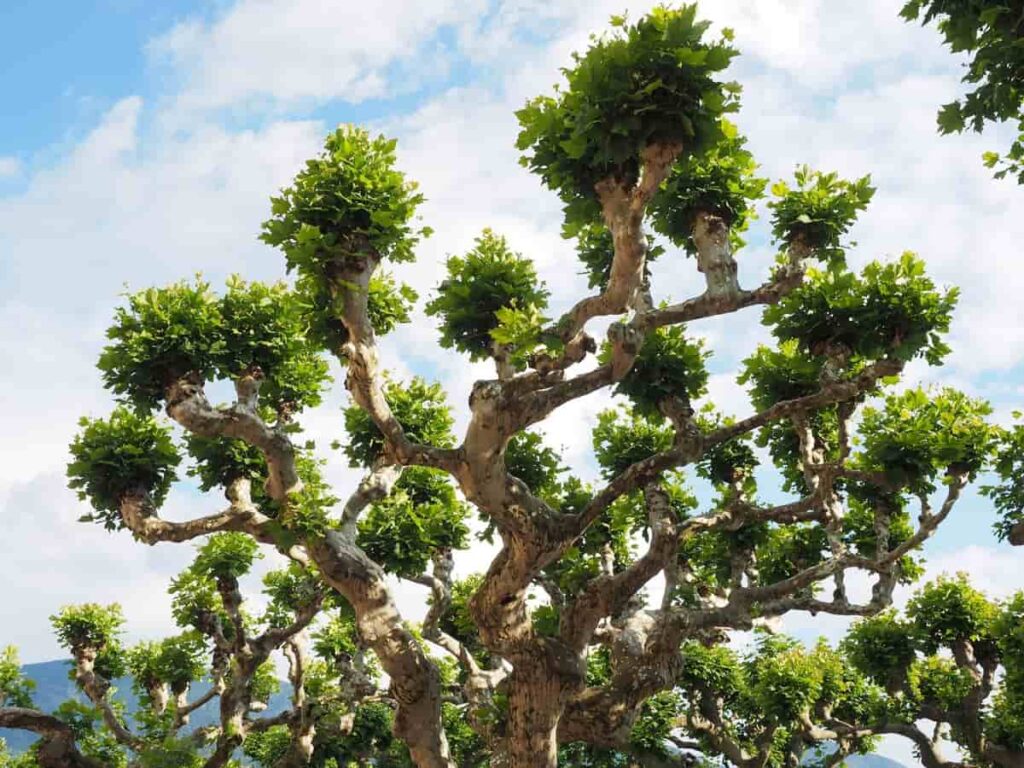
Ensure your Sycamore is prepared for winter’s chill. When the weather is chilly, lay out two inches of mulch around the trunk or base of your Sycamore. As a result, the soil will receive more nutrients and will be able to retain more moisture. In addition, mulch repels pests that can cause trees to become weak and infected. After the mulch has been spread along the Sycamore line, you should line burlap around your tree as the snow falls.
Pests and diseases in a Sycamore tree
They are susceptible to a few diseases and insect pests. To maintain healthy plants, follow recommended cultural practices as the first line of defense against pest problems. Healthier plants can able to resist disease and insect pests.
Diseases in Sycamore tree:
| Disease | Cause and symptoms | Control methods |
Anthracnose | Cause: fungus Apiognomonia Veneta Symptoms: Crinkling and browning of the leaves. New shoots and leaves on infected branches will suddenly die. | Remove and destroy fallen leaves and twigs. Then, for small trees, spring applications of copper fungicides. |
Powdery Mildew | Cause: Erysiphe platani Symptoms: Circular or irregular patches of white to gray powdery material on leaves and twigs. Leaves will turn yellow and drop. | This disease can be controlled by spraying Sulfur and copper fungicides |
Bacterial Leaf Scorch | Cause: Xylella fastidiosa Symptoms: Irregularly shaped areas of scorch (dry and brown tissue) on leaf margins and between leaf veins. | Providing sufficient water, mulch, and fertilizer to infected trees can extend the tree’s life. Trees that are extensively affected should be removed and replaced with non-susceptible trees. |
Black spot | Symptom: Black spot occurs on leaves. Many taupe or blackish-brown spots will form on the backs of leaves and can severely affect the photosynthesis | To treat black spots, collect fallen leaves in the fall and burn them to kill the pathogens. Or, when planting the Sycamore seedlings in late spring, spray fungicides solutions on the backs of the leaves of young trees. |
In case you missed it: How to Grow Okra Plants Faster: Best Tips to Increase Flowering, Fruiting, and Yield
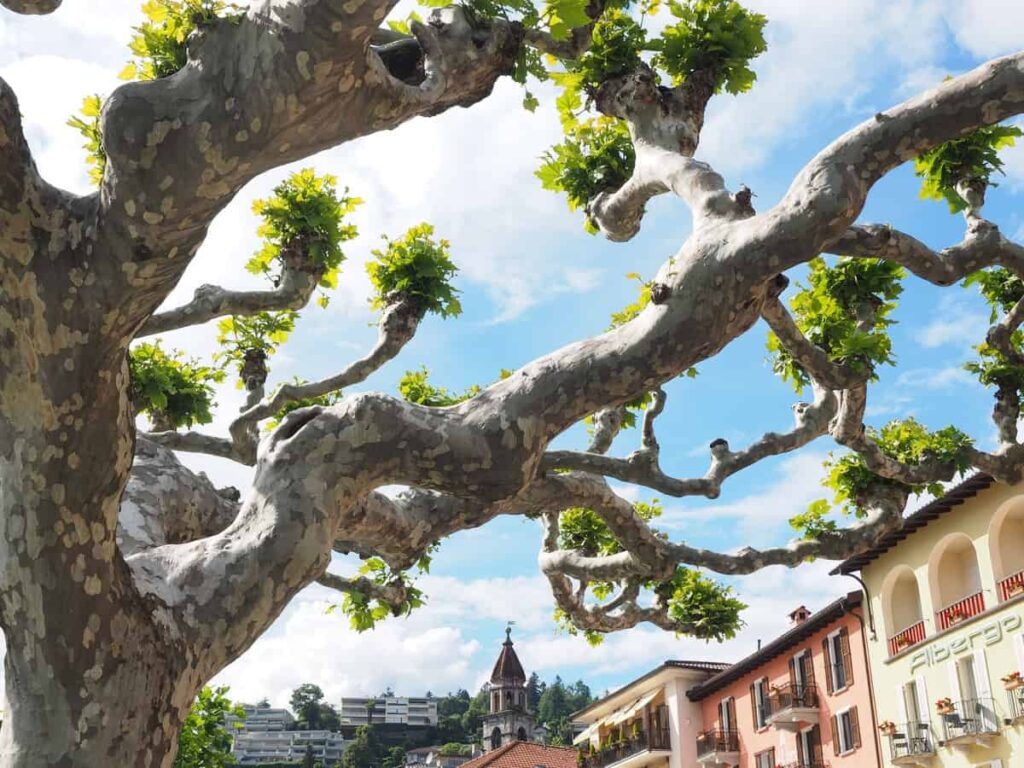
Pests in Sycamore tree
Pest | Symptoms | Control methods |
Sycamore Lace Bug | The leaf tissue turns yellow. The leaf’s lower surface will typically be covered with dark spots of waste material, and the cast-off skins of immature lace bugs | Spraying with a stream of water or insecticidal soap solution can control a light infestation |
| Bagworms | Large populations of bagworms can strip plants of their foliage and eventually cause them to die. | The best method to rid your trees of bagworms is to hand-pick them from the trees. Perform this in the spring before the larvae hatch and in winter when the bags are more easily spotted. |
| Longicorns | Longicorn larvae bore through tree trunks to gnaw on wood, leaving many visible bores and sawdust-like excretion masses outside of them. | They can be killed by injecting pesticides into the bores and sealing them with clay, or they can be prevented and treated with pesticides. |
| Yellow Moths | Yellow moths often show up in summer to feed on leaves. They can eat entire leaf blades in a severe infestation. | Yellow moth larvae are sensitive to pesticides, so in early summer, leaves can be sprayed with pesticides for treatment. |
Conclusion
One of the most famous deciduous trees in the Eastern United States is the Sycamore. Due to their ease of growth, they are also very popular in urban areas. As well as being low-maintenance, Sycamore trees are excellent for rehabilitating soil that isn’t suitable for planting. Sycamores, however, are believed to live.
- Profitable Village Farming Business Ideas in 2024
- High-Yield Aquaculture: Fast-Growing Fish for Farming
- Effective Fish Pond Construction Techniques for Beginners
- Irrigation and Water Management in Pineapple Farming
- Blossom to Harvest: Mastering Flowering and Pollination in Papaya Farming
- Pig Fattening Essentials: From Selection to Sale for Beginners
- Raising Wagyu Cattle: A Complete Guide for Premium Beef Production
- Soil Types and Their Water Holding Capacity
- Optimizing Irrigation Schedules for Coconut Groves for Enhanced Yield
- Espresso Your Garden: Coffee Grounds for Healthier Acid-Loving Plants
- The Best Soil Mix for Snake Plants: How to Mix Your Own Snake Plant Soil
- Green Thumb Success: Expert Tips for Cultivating Greenhouse Beans All Year Round
- Bloom All Year Round: The Ultimate Guide to Indoor Hyacinth Care
- Eco-Friendly Gardening: How to Make Liquid Fertilizer from Kitchen Waste
- Ultimate Guide to Grow Anise in Pots: Explore Seed Propagation to Harvesting
- Guide to Raising Chester White Pigs: Discover Breed Facts to Growth Management
- Mastering the Elegance: The Ultimate Guide to Weeping Cherry Tree Care, Planting, and Maintenance
- Ultimate Guide to Planting Garlic in Grow Bags: Growing Strategies for Beginners
- How to Fix Spider Plant Leaf-Related Problems: Natural and Organic Remedies
- 10 Reasons Why Your Tulsi Plant is Shedding Leaves: Home Remedies and Solutions
- Optimizing Growth and Yield: The Advantages of Palm Bunch Ash Fertilizer
- Utilizing Neem Oil Extract as a Natural Pesticide for Hydrangea
- From Soil to Harvest: Various Ways in Which Farmers Can Use AI Tools
- Steps to Encourage and Induce Citrus Flowers: A Comprehensive Guide
- How to Fix Snake Plant Leaf-Related Issues: Natural and Organic Remedies
- Transform Your Garden into a Fragrant Oasis with Raat Ki Rani (Night Blooming Jasmine)
- Discover the Ideal Chicken Breeds for Philippine Farms
- How to Create a Poultry Egg Farm Business Plan for Profits
- Grow Lemon Cucumbers Like a Pro: Insider Techniques for Bountiful Yields
- Ultimate Guide to Caring for Your Pink Princess Philodendron: Tips for Thriving Variegation
- Areca Nut Profit Per Acre: Calculating Yield and Cost of Cultivation
- How Kaveri Chicken is Becoming a More Profitable Breed in Indian Backyards
- Transform Your Barn: 9 Steps to Convert a Horse Stall into a Chicken Coop
- Exploring Suffolk Sheep Disadvantages with Limitations and Challenges
- Guide to Solving Potted Lemon Tree Problems: How to Revive Lemon Tree in Containers
- Steps to Encourage Female Pumpkin Flowers: Best Strategies for More Flowers and High Yields

